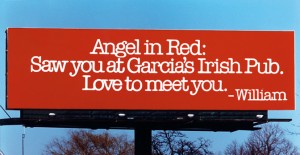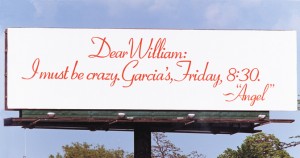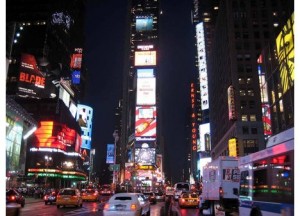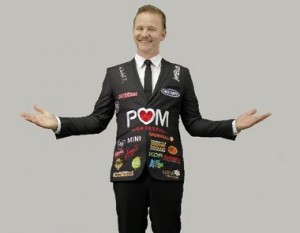 The blog by Drew McLelland The Most Brilliant Outdoor Campaign Ever, is a great read about a great billboard campaign by Garcia’s a local irish pub in Buffalo. The campaign was to create a story of a man trying to meet a girl that he saw at the pub one night by buying billboards that he used to present his messages to her. As McLelland’s blog post stated most outdoor campaigns follow strict guidelines; such as, never use more than seven words, always use an attention getting visual, include the company logo, leave the boards up for a minimum of 30 days to achieve
The blog by Drew McLelland The Most Brilliant Outdoor Campaign Ever, is a great read about a great billboard campaign by Garcia’s a local irish pub in Buffalo. The campaign was to create a story of a man trying to meet a girl that he saw at the pub one night by buying billboards that he used to present his messages to her. As McLelland’s blog post stated most outdoor campaigns follow strict guidelines; such as, never use more than seven words, always use an attention getting visual, include the company logo, leave the boards up for a minimum of 30 days to achieve
 frequency goals and buy several locations. Garcia’s campaign broke all of these rules, yet it was a powerful campaign. What was even more interesting about this campaign was the complete story line the marketing agency (Crowley Webb) conceived which included hiring two actors to play the part of William and Angel who finally met at the very crowded bar (thanks to the campaign) where they danced and then left together in a limo. The blog is overall saying that it is ok for marketers to break rules as long as it is to add extra value for the consumers and in effect is able to capture the imagination of more people. This is an amazing billboard campaign that captured the imagination of all of Buffalo and was featured in some national news papers and ofcourse throughout Buffalo’s media all for the price of renting the billboard for 9 weeks.
frequency goals and buy several locations. Garcia’s campaign broke all of these rules, yet it was a powerful campaign. What was even more interesting about this campaign was the complete story line the marketing agency (Crowley Webb) conceived which included hiring two actors to play the part of William and Angel who finally met at the very crowded bar (thanks to the campaign) where they danced and then left together in a limo. The blog is overall saying that it is ok for marketers to break rules as long as it is to add extra value for the consumers and in effect is able to capture the imagination of more people. This is an amazing billboard campaign that captured the imagination of all of Buffalo and was featured in some national news papers and ofcourse throughout Buffalo’s media all for the price of renting the billboard for 9 weeks.

 between clips while watching T.V. shows on network websites. Unfortunately AdBlock only applies to online advertisements and a short walk in any city will quickly ruin any hopes of block the influence of advertisements in our daily lives. Advertisements are everywhere! News papers, billboards, buses, bus benches. The overall power of advertisement is no longer the ability to intrigue consumers into trying new products with crafty and entertaining marketing; but rather, to continuously bombard consumers with corporate logos all day every day no matter where they are. I believe the efforts of AdBlock are futile because it is only effective at blocking the obvious advertisements. When watching a movie or T.V. show on a network site, AdBlock is able to block out the annoying ads in between clips; however,
between clips while watching T.V. shows on network websites. Unfortunately AdBlock only applies to online advertisements and a short walk in any city will quickly ruin any hopes of block the influence of advertisements in our daily lives. Advertisements are everywhere! News papers, billboards, buses, bus benches. The overall power of advertisement is no longer the ability to intrigue consumers into trying new products with crafty and entertaining marketing; but rather, to continuously bombard consumers with corporate logos all day every day no matter where they are. I believe the efforts of AdBlock are futile because it is only effective at blocking the obvious advertisements. When watching a movie or T.V. show on a network site, AdBlock is able to block out the annoying ads in between clips; however, the viewer is still subject to the large amount of product placement in every modern movie or TV show. So although I would agree, and am thankful for, innovations like AdBlock that remove annoying ads from my online experience, I would make the argument that such innovations have been largely over shadowed by our ability to create new ways of reaching consumers in every aspect of their lives.
the viewer is still subject to the large amount of product placement in every modern movie or TV show. So although I would agree, and am thankful for, innovations like AdBlock that remove annoying ads from my online experience, I would make the argument that such innovations have been largely over shadowed by our ability to create new ways of reaching consumers in every aspect of their lives.

